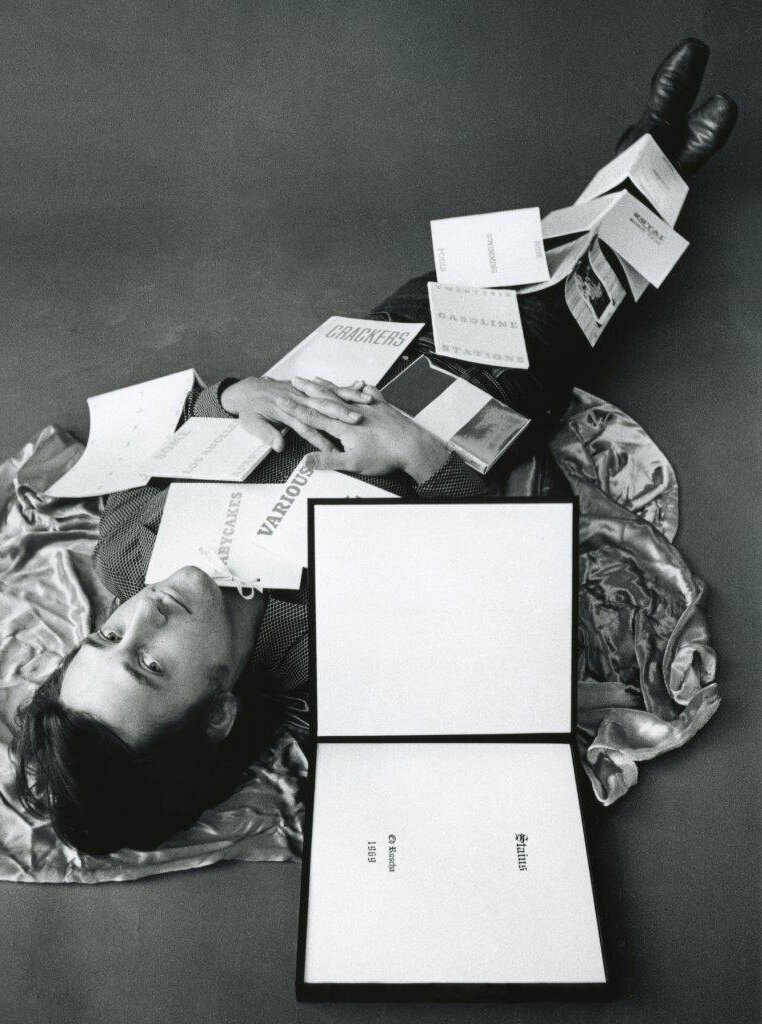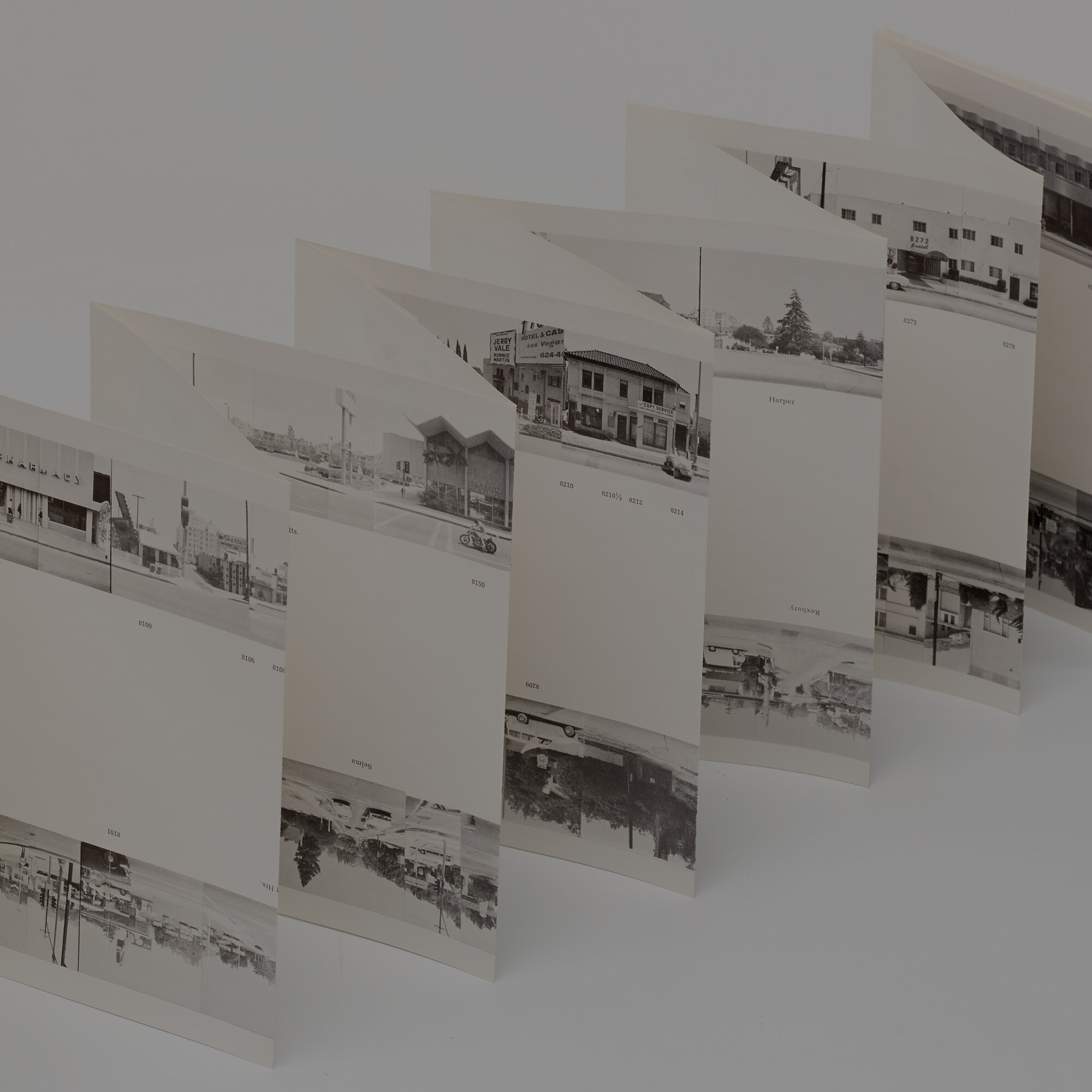26
26
USA, 1966-1978
printed and bound paper
printed and bound paper
estimate: $20,000–30,000
follow artist
Dutch Details Ed Ruscha, Octopus Foundation within the Framework of Sonsbeek 71, 1971. Oblong publication featuring 9 fold-outs showing the artist's bridge-related photography. Signed by the artist behind cover page 'Ed Ruscha'. First edition. Glassine showing minor wear from age, use and handling. Interior pages with minor discoloration. A fine example.
Every Building on the Sunset Strip Ed Ruscha, 1966. This work is from the first edition of 1,000 published by the artist. One of the cleanest examples we have seen, with only a small tear to exterior sleeve.
Crackers Ed Ruscha, Heavy Industry Publications, 1969.
Business Cards Ed Ruscha and Billy Al Bengston, Ed Ruscha & Billy Al Bengston, 1968. Signed by each artist to the front cover 'B.A.B. Edward Ruscha. First edition.
Royal Road Test Ed Rucha, Mason Williams and Patrick Blackwell, Mason Williams and Edward Ruscha, 1967/1971. Spiral bound publication. Third edition of 2000 copies.
Babycakes with Weights Ed Ruscha, Edward Ruscha, 1970. First edition.
Thirtyfour Parking Lots (in Los Angeles) Ed Ruscha, Edward Ruscha, 1967/1974. Second edition of 2000 copies.
A Few Palm Trees Ed Ruscha, Heavy Industry Publications, 1971.
Nine Swimming Pools and A Broken Glass Ed Ruscha, Edward Ruscha, 1968. First edition.
Real Estate Opportunities Ed Ruscha, Edward Ruscha, 1970. First edition.



All my artistic response comes from American things, and I guess I've always had a weakness for heroic imagery.
Ed Ruscha
Ed Ruscha b. 1937
Ed Ruscha is known for his detached, cool gaze over the American landscape, its vernacular and built environments. He is a leading voice in contemporary art, consistently subverting the aesthetic and conceptual conventions of photography and painting, as well as the mythic narratives surrounding American culture.
Ed Ruscha was born in Omaha, Nebraska in 1937 and grew up in Oklahoma City. He moved to Los Angeles in 1956 to attend what is now the California Institute of the Arts. Upon graduating in 1960, Ruscha began working in commercial advertising, putting him in contact with relationships between image and text and the language of consumerism and popular culture. Ruscha’s early drawings and paintings bucked against the prevailing trend of abstract expressionism, depicting wry, irreverent takes on the banality of the urban landscape. In 1962, Ruscha was included in New Painting of Common Objects at the Pasadena Art Museum, a show considered the first museum exhibition of Pop Art that included works by Andy Warhol, Roy Lichtenstein and Wayne Thiebaud.
In 1963, the year Ruscha’s now-famous artist book Twentysix Gasoline Stations was published, he received his first solo show at Ferus Gallery in Los Angeles. Ruscha made sixteen artist books in the 1960s and 1970s, most of them comprised of photography taken in an antagonistically plain, documentary style, covering subjects such as swimming pools, parking lots and Every Building on the Sunset Strip (1966). In his photography and painting, Ruscha does not attempt to idealize his subjects, but rather stares deadpan at the ordinary objects and spaces that exist on the periphery of the experience of our surroundings. Ruscha is also celebrated for his approach to language, which is often amusing, incongruous and common, exploring the multiplicity of words and turning them into solid objects to be contemplated and played with.
Ruscha’s first major retrospective was in 1982 at the San Francisco Museum of Modern Art. The cover of the catalog featured a drawing he had made in 1979, with the text: “I don’t want no retro spective.” Ruscha continues to reside in his adopted city of Los Angeles, actively creating work that speaks to our rapidly changing contemporary landscape, the way we use language and our conception of the American ethos.
Upcoming Lots Ed Ruscha
Auction Results Ed Ruscha